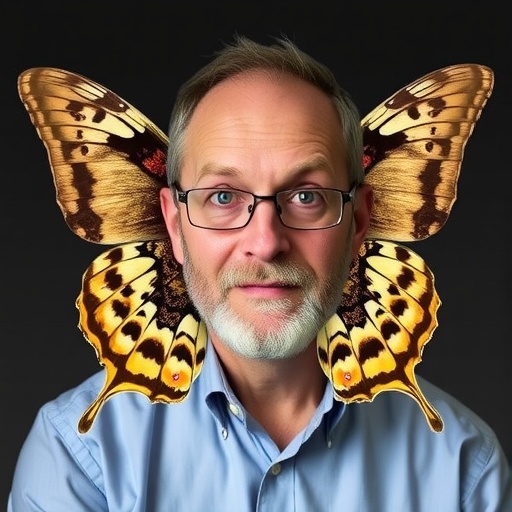Marcin Wiorek has been appointed as co-Editor-in-Chief of the renowned journal Nota Lepidopterologica, joining forces with the current co-Editor-in-Chief, Théo Léger. This significant transition in editorial leadership took place following Wiorek’s election during the Society for European Lepidopterology (SEL) meeting on August 22, 2025. Wiorek steps into the role to succeed David Lees, who concluded his notable eight-year tenure overseeing the journal. This appointment signals a new chapter for Nota Lepidopterologica, promising continued scholarly excellence and innovation in the field of lepidopterology.
Wiorek brings a wealth of expertise to the editorial helm, focusing particularly on tiger moths (subfamily Arctiinae). His scientific endeavors encompass systematics, phylogenetic analysis, biological traits, and zoogeographic patterns of these moths. His in-depth study of Syntomini moths from Madagascar has been pivotal, not only fueling his academic curiosity but also culminating in the achievement of his doctoral degree. His comprehensive knowledge spans molecular biology techniques, morphological scrutiny, and the integration of classical taxonomy with cutting-edge research methodologies, positioning him as a uniquely qualified editor in this specialized niche within entomology.
The outgoing co-Editor-in-Chief, David Lees, reflected on his eight-year journey with Nota Lepidopterologica, underscoring his commitment to maintaining rigorous scientific standards and enhancing the journal’s accessibility globally. Under his leadership, the journal has embraced inclusivity by welcoming contributions from researchers around the world, breaking geographical barriers commonly seen in European-centered publications. Lees co-managed 11 journal issues, which collectively featured 148 rigorous papers across more than 2,000 pages of scientific content. This substantial editorial work has solidified Nota Lepidopterologica as a vital platform for lepidopterological scholarship.
A notable milestone during Lees’ editorial leadership was the introduction of an official Journal Impact Factor (JIF) for Nota Lepidopterologica, currently standing at 0.7. This bibliometric indicator reflects the journal’s growing influence within the scientific community. Additionally, submissions benefit from integrated metrics such as Altmetric scores, providing authors and readers with a multidimensional view of each paper’s reach and impact. Pensoft Publishers, the journal’s publisher, has played a vital role in supporting these advancements, offering innovative dissemination strategies to amplify research visibility.
David Lees expressed confidence in Wiorek’s appointment, emphasizing their shared experiences and collaborations, especially fieldwork conducted in Madagascar. He praised Wiorek’s scientific acumen, linguistic proficiency, and technical expertise, all crucial attributes for overseeing the increasingly multidisciplinary submissions received by Nota Lepidopterologica. Lees’ continued role as Senior Curator at the Natural History Museum in London ensures his ongoing contribution to microlepidoptera research, where he plans to focus on his personal scientific projects with renewed vigor.
Marcin Wiorek himself conveyed enthusiasm for joining the editorial team, honoring the legacy of his predecessor and predecessors alike. He highlighted the crucial intersection of traditional taxonomy with modern molecular and bioinformatics approaches. His multidisciplinary approach aims to uphold and elevate the journal’s status by attracting novel, integrative studies that advance lepidopteran science. Wiorek also acknowledged the subtle cultural and linguistic nuances shared within the SEL community, humorously noting the importance of the English language in navigating professional and fieldwork interactions.
Nota Lepidopterologica, established in 1977, remains the authoritative publication of the Society for European Lepidopterology. It specializes in high-quality research outputs covering a broad spectrum of lepidopterological topics, including taxonomy, morphology, phylogenetics, biogeography, ecology, behavior, conservation, and natural history. The journal’s adherence to an open-access model reflects the commitment to democratize scientific knowledge, making research freely available to researchers worldwide and facilitating global collaboration and knowledge dissemination.
The journal is part of Pensoft’s extensive portfolio of entomology publications and is published via the ARPHA platform, a cutting-edge digital ecosystem designed to streamline editorial workflows and enhance article presentation through semantic enrichments and integrated data features. Nota Lepidopterologica’s content is secured and archived through multiple international repositories such as CLOCKSS, Zenodo, and Portico, ensuring long-term preservation and accessibility for the scientific community.
Pensoft Publishers, an independent open-access provider, is widely recognized for pioneering innovations in biodiversity publishing. Their flagship journal, ZooKeys, revolutionized zoological publishing by being the first to launch as a digital-first outlet and to incorporate semantic enhancements that enrich biodiversity data accessibility and interoperability. Pensoft continues to develop advanced tools and workflows supporting biodiversity informatics, including ambitious projects like the OpenBiodiv knowledge graph and the Horizon 2020-funded BiCIKL initiative, which integrate diverse biological datasets to enhance research efficiency.
The transition in editorial leadership at Nota Lepidopterologica not only honors the substantial contributions of David Lees but also heralds a promising future under Marcin Wiorek’s guidance. The journal is well-positioned to maintain its high scholarly standards while embracing evolving scientific methodologies and expanding its global reach. Such developments affirm the journal’s vital role in advancing lepidopterology and underscore Pensoft’s commitment to fostering open and innovative scientific communication within the life sciences.
Readers and contributors alike can anticipate continued excellence, increased visibility, and enhanced integration of multidisciplinary approaches in future Nota Lepidopterologica issues. The seamless collaboration between the journal’s editorial team and Pensoft’s technological infrastructure promises a progressive publishing environment that supports rigorous peer review, data transparency, and broad dissemination of findings. This synergy is crucial for driving forward the understanding of Lepidoptera and enriching the broader entomological knowledge base.
With a diverse and growing readership spanning academic researchers, conservationists, and biodiversity informatics specialists, Nota Lepidopterologica under the new leadership will continue to be a cornerstone publication. Its commitment to open access, editorial rigor, and scientific innovation ensures that it remains at the forefront of lepidopterological research. This editorial evolution represents not merely a change in stewardship but an inflection point poised to inspire new discoveries, collaborations, and advancements within the global scientific community.
Subject of Research: Lepidopterology, with focus on systematics, phylogeny, and biology of tiger moths (Arctiinae), and broader lepidopteran taxonomy and morphology.
News Publication Date: Not explicitly provided; event date August 22, 2025, implies news circa late August 2025.
Web References:
- Nota Lepidopterologica journal
- Society for European Lepidopterology (SEL)
- Pensoft Publishers
- David Lees profile, Natural History Museum, London
- ARPHA platform
- OpenBiodiv knowledge graph
- BiCIKL project
Keywords: Academic publishing, Lepidoptera, Open access, Publishing industry, Scientific community




